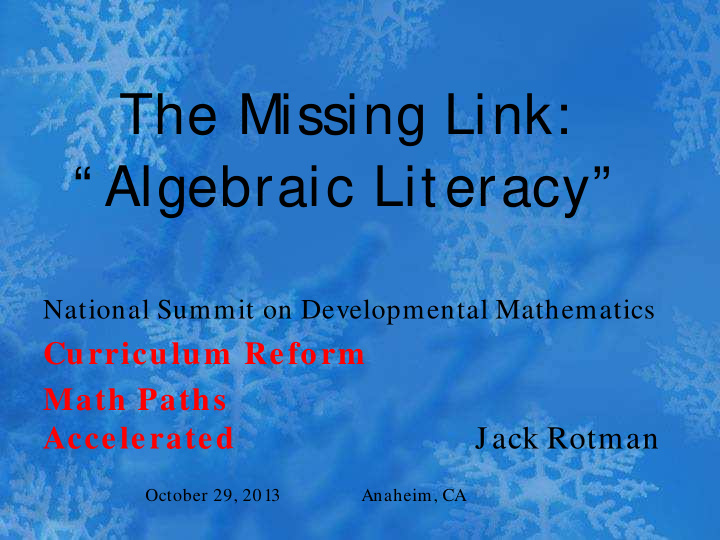



The Missing Link: “ Algebraic Literacy” National Summit on Developmental Mathematics Curriculum Reform Math Paths Accelerated Jack Rotman October 29, 2013 Anaheim, CA
Before we are done … • Know what roles ‘algebraic literacy’ has in our curriculum • See the math paths that use this course • Review content in some detail • See a sample lesson • Get 3 handouts (paths, outcomes, sample)
Matching to your Needs • Curricular Reform Content that is directly connected to student needs • Math Paths Sequence of courses appropriate to student programs • Acceleration Shorten the sequence of courses for most students • Increased Context; focus on reasoning
The KEY Point • Traditional algebra curriculum wastes student time, does not meet student needs • Students preparing for math-intensive courses have specific needs • Students in technology programs have needs which are consistent • Preparation for biology courses • Needs: understanding and reasoning as well as procedure; not just algebra
Now and Then (1) • Algebraic Literacy: Designed to provide background needed for college algebra, pre-calculus, biology and technology, in a coherent package • Intermediate Algebra: Descendent of high school ‘algebra II’ traditional content, presumed needed for STEM, often presented as isolated topics
Designing ‘ Algebraic Literacy’ Path – Prepare Reference students for Pre-calculus MAA College Algebra Guidelines (2007) ( calculus) MAA Curriculum Guide (2004) College Algebra – MAA College Algebra Guidelines Reform Models AMATYC Right Stuff Biology MAA CRAFTY Curricular Foundations – Biology Technology Programs AMATYC CRAFTY “Vision” project
Handout 1 • References on one side • Curricular ‘vision’ from the New Life Project on the other side
Now and Then (2) • Algebraic Literacy (AL): Understanding; balance of symbolic and graphical methods, often in context with meaningful applications • Intermediate Algebra: Symbolic procedures, correct answers, and stylized applications
Curricular Context • Algebraic Literacy can follow either ◊ a beginning algebra course or ◊ a Math Lit course • Students placing in to intermediate algebra would be ready for Algebraic Literacy (AL) • Some students placed in Beginning Algebra could start in AL
Algebraic Lit Paths to Calc.
Algebraic Lit: College Algebra, Biology, Technology Paths AL also serves students in emerging technologies: bio tech; enviro tech; info tech; manufacturing tech; etc
Now and Then (3): Content • AL: Primary focus: Algebra concepts and procedures. Secondary focus: Geometry, Trigonometry, Statistics • Intermediate Algebra: Algebraic symbolism and puzzle word problems. Some coincidental geometry
Overview of Content in AL • Num bers and Polynom ials Expressions and Equations; symbolic and numeric • Functions (linear, exponential, power) Representations, key concepts (‘rate of change’) • Geom etry & Trigonom etry Properties of shapes; patterns of measurement Basic Right Triangle Trig • Modeling & Statistics Theoretical versus modeled functions; use technology; basic understanding of correlation
Now and Then (4): Taglines • AL: Balance of symbolic work and applications of good mathematics • Intermediate Algebra: 1000 answers and a cloud of dust
Benefits of Algebraic Literacy • Content based on student need • Fits 4 key math paths • Shorter course sequences: shorter paths (acceleration) • More context, increased focus on reasoning skills • Adapts to local needs
Related to Algebraic Literacy … • The Algebraic Literacy course is from the AMATYC New Life Project (Dev Math Comm) • The Dana Center New Mathways project will have a path similar to AL • New Mathways focuses on district or state implementation • New Life: focus on faculty; adapting to local conditions • Carnegie Foundation Pathways do not have this path
Second Handout • AL Content Goals and Outcomes [Cross-referenced to the four paths (targets)]
Numbers and Polynomials • Parameters & Variables • Procedural Fluency with Polynomials • Use equations, inequalities, and systems to represent situations (symbolic, numeric, and graphical) • Use exponential and power equations to represent situations (numeric, graphical) • Symbolic procedures – formulas, literal equations • Outcomes for STEM Paths
Functions • Understand basic algebraic functions (Linear, exponential, power) • Write the appropriate function • Discrete or continuous model • Understand properties of functions Rate of change, min/ max, effects of parameters • Outcomes for STEM Paths
Geometry and Trigonometry • Properties of basic shapes • Understand patterns of measurement (perimeter, area, volume) • Understand sine, cosine and tangent in right triangle context • Use 3 basic trig functions (with technology)
Modeling and Statistics • Basic concepts of measurement • Understand theoretical versus modeled relationships (‘errors’) • Use technology to generate models from data (linear, exponential, power) • Understand how to judge which model is a better choice
Now and Then (5): Basic Story Line • AL: Key algebraic concepts and procedures, with functions and rate of change, using symbolic and numeric methods, to understand science and the world • Intermediate Algebra: Ten chapters of skills organized around the type of objects being used, with very little continuity between topics and minimal connections for concepts
Sample AL Lesson (‘ 4.x’ ) • See the Handout • Content is integrated, often represents a real situation • Four content goals are not likely to be ‘chapters’ in a book • Connections – multiple methods – understanding – representations
Materials for AL • Some authors are currently writing materials • Perhaps you will want to be involved • Some existing materials can be adapted (books with a strong ‘multiple representations’ focus)
Closing • Optional Handout – MLCS content • Other Questions • Discussion • See handouts for email and web sites • Related Session: Math Lit (Wed, 9:15) Jack Rotman rotmanj@lcc.edu www.devmathrevival.net dm-live.wikispaces.com
Recommend
More recommend